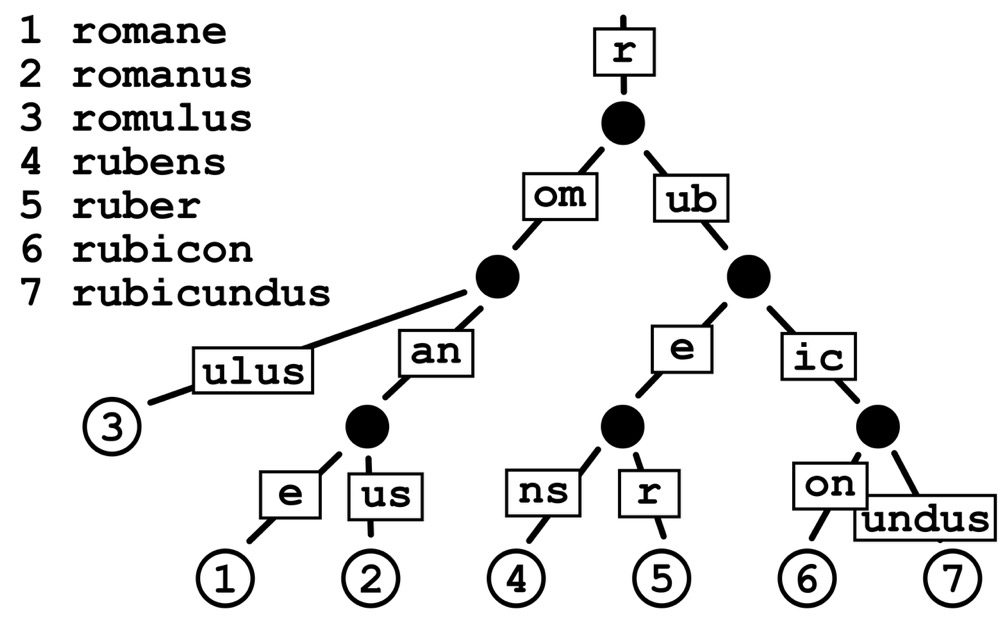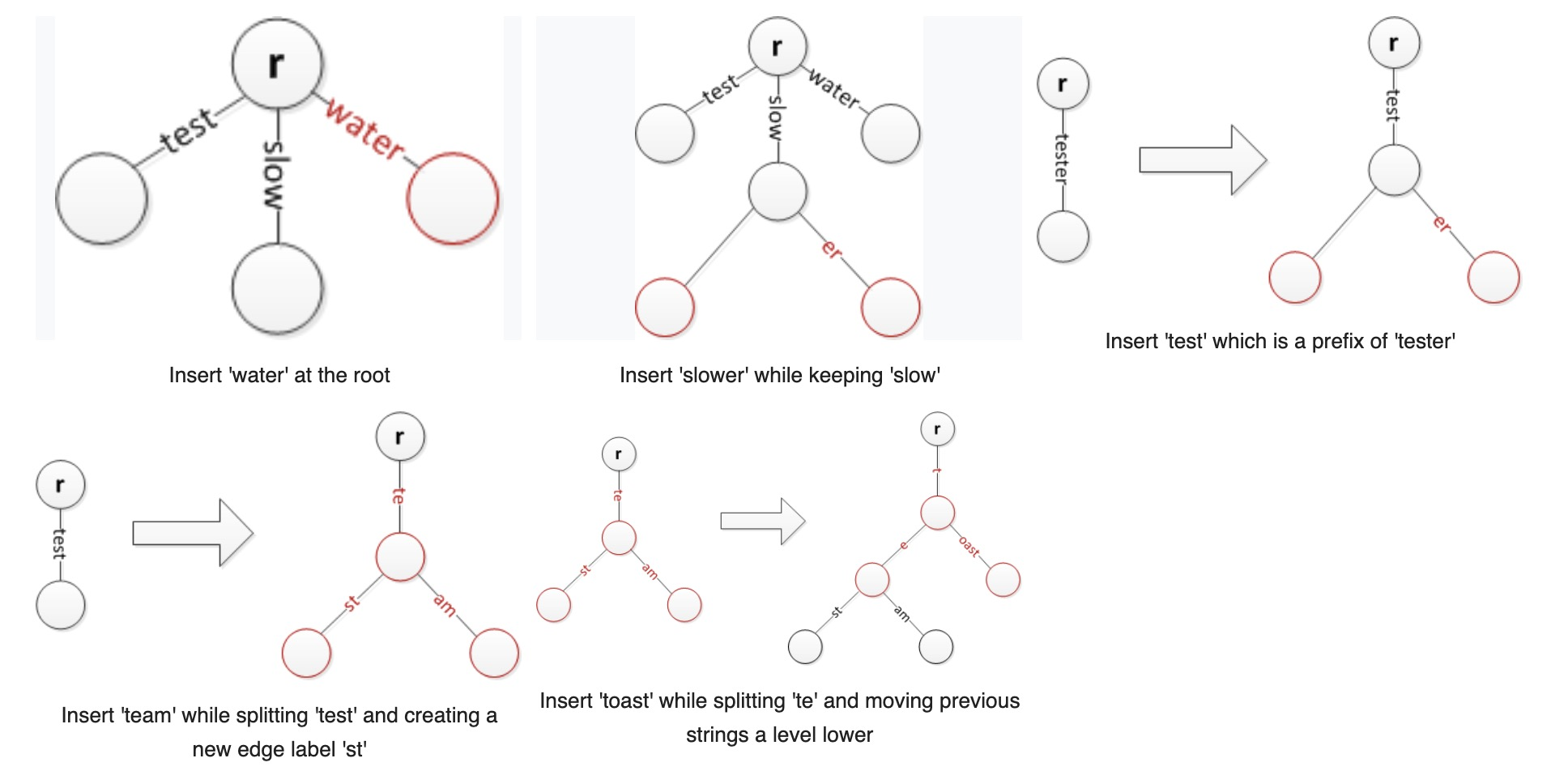Radix树简介
Radix Tree名为压缩前缀树,又名为基数树。听名字,就知道该算法是之前介绍的前缀树的压缩版,也就是具有共同前缀的节点拥有相同的父节点。和前缀树Trie Tree极为相似,一个最大的区别点在于它不是按照每个字符长度做节点拆分,而是可以以1个或多个字符叠加作为一个分支。这就避免了长字符key会分出深度很深的节点。Radix Tree的结构构造如下图所示:
Trie Tree 参考http前缀树路由算法和Go源码分析

针对Radix Tree的构造规则,它的节点插入和删除行为相比较于Trie Tree来说,略有不同:
- 对于节点插入而言,当有新的key进来,需要拆分原有公共前缀分支。
- 对于节点删除而言,当删除一个现有key后,发现其父节点只有另外一个子节点key,则此子节点可以和父节点合并为一个新的节点,以此减少树的比较深度。

web框架中的快速路由 基数树
Priority Path Handle
9 \ *<1>
3 ├s nil
2 |├earch\ *<2>
1 |└upport\ *<3>
2 ├blog\ *<4>
1 | └:post nil
1 | └\ *<5>
2 ├about-us\ *<6>
1 | └team\ *<7>
1 └contact\ *<8>
// 这个图相当于注册了下面这几个路由
GET("/search/", func1)
GET("/support/", func2)
GET("/blog/:post/", func3)
GET("/about-us/", func4)
GET("/about-us/team/", func5)
GET("/contact/", func6)通过上面的示例可以看出:
- *<数字> 代表一个 handler 函数的内存地址(指针)
- search 和 support 拥有共同的父节点 s ,并且 s 是没有对应的 handle 的, 只有叶子节点(就是最后一个节点,下面没有子节点的节点)才会注册 handler 。
- 从根开始,一直到叶子节点,才是路由的实际路径。
- 路由搜索的顺序是从上向下,从左到右的顺序,为了快速找到尽可能多的路由,包含子节点越多的节点,优先级越高。
golang实现
route,node结构体:
type Router struct {
trees map[string]*node
...
}因为github.com/julienschmidt/httprouter是生产可用的路由模块,加入了很多细节的考虑,比如:
- 是否处理当访问路径最后带的 /
- 是否自动修正路径, 如果路由没有找到时,Router 会自动尝试修复
- 自定义 OPTIONS 路由
- 自定义http NotFound handler函数
- 自定义错误恢复handler函数
- 定义静态文件目录
- 等等
本篇主要分析路由基数树算法相关的代码,非相关的其他代码略过。
路由算法主要包括路由注册和路由发现两个部分:
路由注册
基数树算法相较于前缀树算法之所以快,主要在于:
- 进一步压缩前缀树,即:同前缀的节点拥有相同的父节点
- 对子节点建立了索引并按优先级从左到右排列,并将该信息保存在node结构体的indices字符数组里
下面的incrementChildPrio方法做了下面几件事:
- 根据入参的下标,修改对应下标的子节点的优先级
- 调整子节点数组的顺序,具体将+1优先级的子节点的优先级依次和前一个子节点的优先级做比较,若高,则互换位置
- 重新索引。若重新排列过子节点,即 newPos != pos,即按调整后的子节点顺序重新建立索引。索引就是个字符数组,各取子节点的首字符
- 返回最新索引的调整后的位置
通过建立按优先级排序的索引,可以极大缩短路由查找时间,实现快速路由。该索引不仅用在路由发现,路由注册也用到了,大大加快速度。
// Increments priority of the given child and reorders if necessary
func (n *node) incrementChildPrio(pos int) int {
cs := n.children
cs[pos].priority++
prio := cs[pos].priority
// Adjust position (move to front)
newPos := pos
for ; newPos > 0 && cs[newPos-1].priority < prio; newPos-- {
// Swap node positions
cs[newPos-1], cs[newPos] = cs[newPos], cs[newPos-1]
}
// Build new index char string
if newPos != pos {
n.indices = n.indices[:newPos] + // Unchanged prefix, might be empty
n.indices[pos:pos+1] + // The index char we move
n.indices[newPos:pos] + n.indices[pos+1:] // Rest without char at 'pos'
}
return newPos
}整个addRoute和insertChild方法的代码是相当绕的,但好在大多数代码在处理通配符冒号和星号,以及检测通配符冲突和不合法上面,跳过这些代码,就简单很多。(下面分析的就跳过这些内容)
addRoute方法处理下面几种情况:
- 若是该节点是下面是空的,就是空树的情况,即当前的path和索引都为空,insertChild,并设置为root类型的节点。
- 若入参的path和该节点有开头有重复的字段,并重复字段没有包括当前整个节点,则对该节点进行裂变,裂变成两节点。共通的节点和原节点剩下的部分作为子节点。
- 若入参的path和该节点有开头有重复的字段,并重复字段包括当前整个节点,则对重复字段之后的字段进行处理(这部分内容分为下面2种情况)。
情况1. 若首字母可以在索引列表中找到,则增加该索引对应的子节点的优先级,并重新回到for循环开头对该子节点进行递归处理(该子节点变为当前节点),直至整个完整URL都被解析完成,并完成所有节点的更新。
情况2. 若首字母可以在索引列表中未找到,则新建子节点,加入新索引,新索引优先级+1,对新的子节点调用insertChild方法。
这个标识符walk名字一目了然,walk整个URL,walk整个tree。
insertChild方法就干了一件事:入参的path和handler函数赋值给node结构体。
由于基数树的特点,上面addRoute方法的整个过程有两处会调用insertChild方法,该方法会将未解析的整段的URL作为子节点插入当前树上。一处是空树的情况,一处是索引列表找不到的情况。换个说法就是,当前树没有任何节点时,第一个注册路由不管多长,都只增加一个节点,这和前缀树算法有明显区别,当索引找不到时,不管未解析的路由有多长,也只插入一个子节点。从这里可以看出之所以称为快速路由的原因。
// addRoute adds a node with the given handle to the path.
// Not concurrency-safe!
func (n *node) addRoute(path string, handle Handle) {
fullPath := path
n.priority++
// Empty tree
if n.path == "" && n.indices == "" {
n.insertChild(path, fullPath, handle)
n.nType = root
return
}
walk:
for {
// Find the longest common prefix.
// This also implies that the common prefix contains no ':' or '*'
// since the existing key can't contain those chars.
i := longestCommonPrefix(path, n.path)
// Split edge
if i < len(n.path) {
child := node{
path: n.path[i:],
wildChild: n.wildChild,
nType: static,
indices: n.indices,
children: n.children,
handle: n.handle,
priority: n.priority - 1,
}
n.children = []*node{&child}
// []byte for proper unicode char conversion, see #65
n.indices = string([]byte{n.path[i]})
n.path = path[:i]
n.handle = nil
n.wildChild = false
}
// Make new node a child of this node
if i < len(path) {
path = path[i:]
if n.wildChild {
n = n.children[0]
n.priority++
// Check if the wildcard matches
if len(path) >= len(n.path) && n.path == path[:len(n.path)] &&
// Adding a child to a catchAll is not possible
n.nType != catchAll &&
// Check for longer wildcard, e.g. :name and :names
(len(n.path) >= len(path) || path[len(n.path)] == '/') {
continue walk
} else {
// Wildcard conflict
pathSeg := path
if n.nType != catchAll {
pathSeg = strings.SplitN(pathSeg, "/", 2)[0]
}
prefix := fullPath[:strings.Index(fullPath, pathSeg)] + n.path
panic("'" + pathSeg +
"' in new path '" + fullPath +
"' conflicts with existing wildcard '" + n.path +
"' in existing prefix '" + prefix +
"'")
}
}
idxc := path[0]
// '/' after param
if n.nType == param && idxc == '/' && len(n.children) == 1 {
n = n.children[0]
n.priority++
continue walk
}
// Check if a child with the next path byte exists
for i, c := range []byte(n.indices) {
if c == idxc {
i = n.incrementChildPrio(i)
n = n.children[i]
continue walk
}
}
// Otherwise insert it
if idxc != ':' && idxc != '*' {
// []byte for proper unicode char conversion, see #65
n.indices += string([]byte{idxc})
child := &node{}
n.children = append(n.children, child)
n.incrementChildPrio(len(n.indices) - 1)
n = child
}
n.insertChild(path, fullPath, handle)
return
}
// Otherwise add handle to current node
if n.handle != nil {
panic("a handle is already registered for path '" + fullPath + "'")
}
n.handle = handle
return
}
}func (n *node) insertChild(path, fullPath string, handle Handle) {
for {
// Find prefix until first wildcard
wildcard, i, valid := findWildcard(path)
if i < 0 { // No wilcard found
break
}
// The wildcard name must not contain ':' and '*'
if !valid {
panic("only one wildcard per path segment is allowed, has: '" +
wildcard + "' in path '" + fullPath + "'")
}
// Check if the wildcard has a name
if len(wildcard) < 2 {
panic("wildcards must be named with a non-empty name in path '" + fullPath + "'")
}
// Check if this node has existing children which would be
// unreachable if we insert the wildcard here
if len(n.children) > 0 {
panic("wildcard segment '" + wildcard +
"' conflicts with existing children in path '" + fullPath + "'")
}
// param
if wildcard[0] == ':' {
if i > 0 {
// Insert prefix before the current wildcard
n.path = path[:i]
path = path[i:]
}
n.wildChild = true
child := &node{
nType: param,
path: wildcard,
}
n.children = []*node{child}
n = child
n.priority++
// If the path doesn't end with the wildcard, then there
// will be another non-wildcard subpath starting with '/'
if len(wildcard) < len(path) {
path = path[len(wildcard):]
child := &node{
priority: 1,
}
n.children = []*node{child}
n = child
continue
}
// Otherwise we're done. Insert the handle in the new leaf
n.handle = handle
return
}
// catchAll
if i+len(wildcard) != len(path) {
panic("catch-all routes are only allowed at the end of the path in path '" + fullPath + "'")
}
if len(n.path) > 0 && n.path[len(n.path)-1] == '/' {
panic("catch-all conflicts with existing handle for the path segment root in path '" + fullPath + "'")
}
// Currently fixed width 1 for '/'
i--
if path[i] != '/' {
panic("no / before catch-all in path '" + fullPath + "'")
}
n.path = path[:i]
// First node: catchAll node with empty path
child := &node{
wildChild: true,
nType: catchAll,
}
n.children = []*node{child}
n.indices = string('/')
n = child
n.priority++
// Second node: node holding the variable
child = &node{
path: path[i:],
nType: catchAll,
handle: handle,
priority: 1,
}
n.children = []*node{child}
return
}
// If no wildcard was found, simply insert the path and handle
n.path = path
n.handle = handle
}路由发现
路由发现和路由注册的过程是类似的并且相对简单,搞懂了路由注册自然就搞懂了路由发现,这里略过。
// Returns the handle registered with the given path (key). The values of
// wildcards are saved to a map.
// If no handle can be found, a TSR (trailing slash redirect) recommendation is
// made if a handle exists with an extra (without the) trailing slash for the
// given path.
func (n *node) getValue(path string, params func() *Params) (handle Handle, ps *Params, tsr bool) {
walk: // Outer loop for walking the tree
for {
prefix := n.path
if len(path) > len(prefix) {
if path[:len(prefix)] == prefix {
path = path[len(prefix):]
// If this node does not have a wildcard (param or catchAll)
// child, we can just look up the next child node and continue
// to walk down the tree
if !n.wildChild {
idxc := path[0]
for i, c := range []byte(n.indices) {
if c == idxc {
n = n.children[i]
continue walk
}
}
// Nothing found.
// We can recommend to redirect to the same URL without a
// trailing slash if a leaf exists for that path.
tsr = (path == "/" && n.handle != nil)
return
}
// Handle wildcard child
n = n.children[0]
switch n.nType {
case param:
// Find param end (either '/' or path end)
end := 0
for end < len(path) && path[end] != '/' {
end++
}
// Save param value
if params != nil {
if ps == nil {
ps = params()
}
// Expand slice within preallocated capacity
i := len(*ps)
*ps = (*ps)[:i+1]
(*ps)[i] = Param{
Key: n.path[1:],
Value: path[:end],
}
}
// We need to go deeper!
if end < len(path) {
if len(n.children) > 0 {
path = path[end:]
n = n.children[0]
continue walk
}
// ... but we can't
tsr = (len(path) == end+1)
return
}
if handle = n.handle; handle != nil {
return
} else if len(n.children) == 1 {
// No handle found. Check if a handle for this path + a
// trailing slash exists for TSR recommendation
n = n.children[0]
tsr = (n.path == "/" && n.handle != nil) || (n.path == "" && n.indices == "/")
}
return
case catchAll:
// Save param value
if params != nil {
if ps == nil {
ps = params()
}
// Expand slice within preallocated capacity
i := len(*ps)
*ps = (*ps)[:i+1]
(*ps)[i] = Param{
Key: n.path[2:],
Value: path,
}
}
handle = n.handle
return
default:
panic("invalid node type")
}
}
} else if path == prefix {
// We should have reached the node containing the handle.
// Check if this node has a handle registered.
if handle = n.handle; handle != nil {
return
}
// If there is no handle for this route, but this route has a
// wildcard child, there must be a handle for this path with an
// additional trailing slash
if path == "/" && n.wildChild && n.nType != root {
tsr = true
return
}
if path == "/" && n.nType == static {
tsr = true
return
}
// No handle found. Check if a handle for this path + a
// trailing slash exists for trailing slash recommendation
for i, c := range []byte(n.indices) {
if c == '/' {
n = n.children[i]
tsr = (len(n.path) == 1 && n.handle != nil) ||
(n.nType == catchAll && n.children[0].handle != nil)
return
}
}
return
}
// Nothing found. We can recommend to redirect to the same URL with an
// extra trailing slash if a leaf exists for that path
tsr = (path == "/") ||
(len(prefix) == len(path)+1 && prefix[len(path)] == '/' &&
path == prefix[:len(prefix)-1] && n.handle != nil)
return
}
}基础方法
- min 返回较小的值
- longestCommonPrefix 返回两个字符串最长相同字符的下标的下一个下标
- findWildcard 返回是否匹配到的通配符,返回的内容通配符例如:“:land”,“*land/”,起始下标,是否合法
- countParams 返回通配符个数
func min(a, b int) int {
if a <= b {
return a
}
return b
}
func longestCommonPrefix(a, b string) int {
i := 0
max := min(len(a), len(b))
for i < max && a[i] == b[i] {
i++
}
return i
}
// Search for a wildcard segment and check the name for invalid characters.
// Returns -1 as index, if no wildcard was found.
func findWildcard(path string) (wilcard string, i int, valid bool) {
// Find start
for start, c := range []byte(path) {
// A wildcard starts with ':' (param) or '*' (catch-all)
if c != ':' && c != '*' {
continue
}
// Find end and check for invalid characters
valid = true
for end, c := range []byte(path[start+1:]) {
switch c {
case '/':
return path[start : start+1+end], start, valid
case ':', '*':
valid = false
}
}
return path[start:], start, valid
}
return "", -1, false
}
func countParams(path string) uint16 {
var n uint
for i := range []byte(path) {
switch path[i] {
case ':', '*':
n++
}
}
return uint16(n)
}转载请注明来源,欢迎指出任何有错误或不够清晰的表达。可以邮件至 backendcloud@gmail.com

